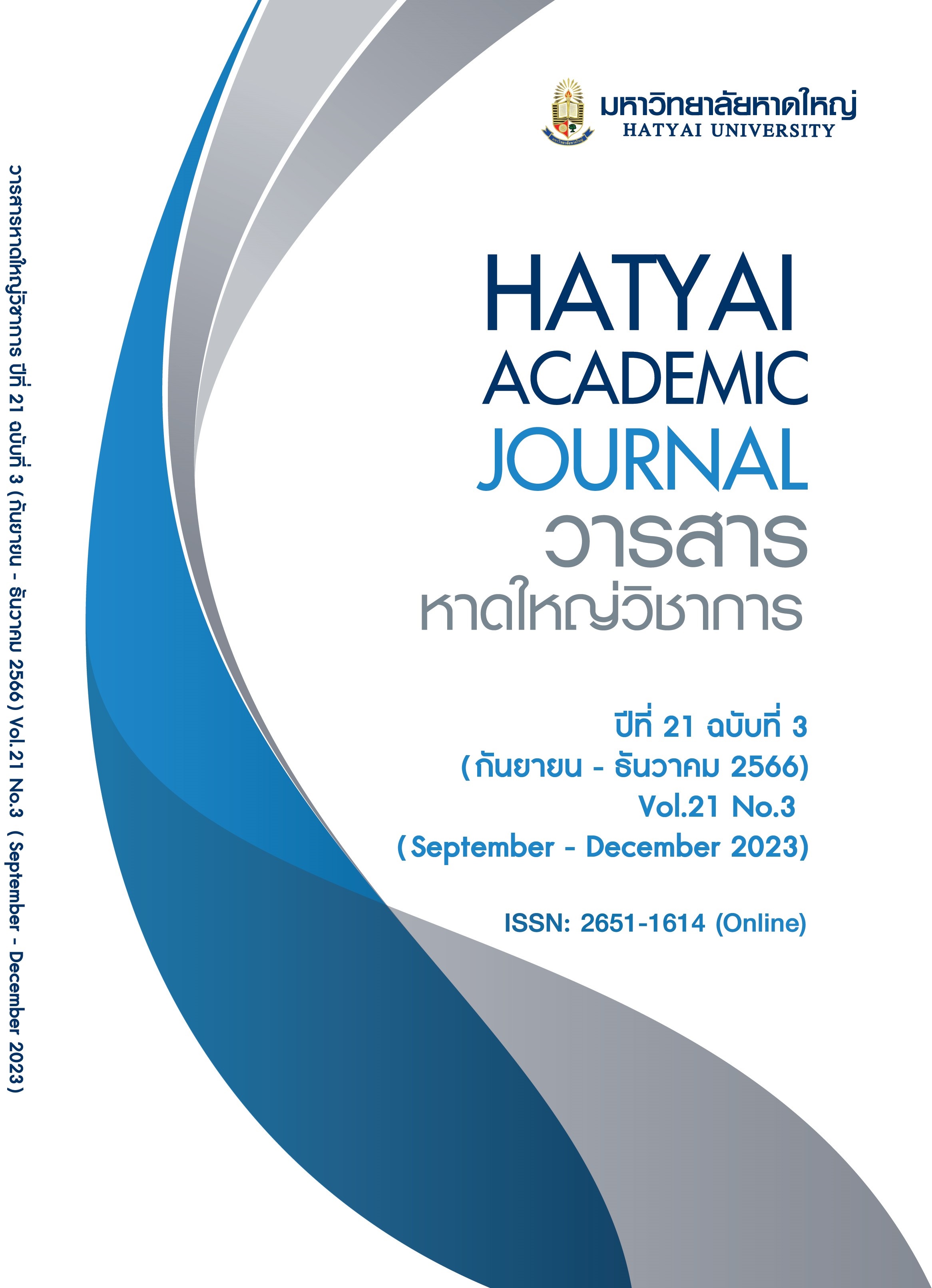รูปแบบการเชื่อมโยงผลการวิจัยด้านการท่องเที่ยวไปสู่การใช้ประโยชน์ของผู้ประกอบการธุรกิจท่องเที่ยวในกลุ่มท่องเที่ยวอันดามัน
Main Article Content
บทคัดย่อ
วัตถุประสงค์ของงานวิจัยนี้เพื่อพัฒนารูปแบบการเชื่อมโยงผลการวิจัยด้านการท่องเที่ยวไปสู่การใช้ประโยชน์ของผู้ประกอบการธุรกิจท่องเที่ยวในกลุ่มท่องเที่ยวอันดามัน เป็นการวิจัยแบบผสมวิธีแบบคู่ขนานใช้ทั้งผลการวิเคราะห์ข้อมูลเชิงปริมาณและเชิงคุณภาพ ประชากรในการวิจัย ได้แก่ ผู้ประกอบการธุรกิจท่องเที่ยวในกลุ่มท่องเที่ยวอันดามัน ผู้วิจัย และตัวแทนของแหล่งทุน การวิจัยครั้งนี้ใช้กลุ่มตัวอย่างในการวิจัยเชิงปริมาณ จำนวน 400 ตัวอย่าง สถิติที่ใช้ในการวิเคราะห์ข้อมูล ประกอบด้วย ค่าแจกแจงความถี่ ค่าร้อยละ ค่าเฉลี่ย ส่วนเบี่ยงเบนมาตรฐาน และค่าสัมประสิทธิ์การถดถอย การวิจัยเชิงคุณภาพใช้กลุ่มตัวอย่าง จำนวน 40 ตัวอย่าง ใช้การสัมภาษณ์เชิงลึก และการสนทนา วิเคราะห์ข้อมูลโดยใช้เทคนิควิเคราะห์เนื้อหา ผลการวิจัยพบว่า ลักษณะของผลงานวิจัยด้านการท่องเที่ยวในกลุ่มท่องเที่ยวอันดามันที่มีการจัดทำในช่วงระยะเวลา 10 ปี (พ.ศ. 2552 - 2562) มีจำนวนงานวิจัยทั้งหมด 123 เรื่อง การเผยแพร่งานวิจัยมีทั้งในรูปแบบของการตีพิมพ์บทความในวารสารวิชาการ การนำผลงานวิจัยเข้าสู่ระบบฐานข้อมูลสืบค้นห้องสมุดออนไลน์ การนำเสนอในการประชุมวิชาการทั้งในประเทศและระดับนานาชาติ ปัจจัยที่ส่งผลต่อการนำงานวิจัยไปใช้ประโยชน์ พบว่า ค่าตัวแปรพยากรณ์ ได้แก่ ด้านผู้วิจัย ด้านการสื่อสารผลงานวิจัย และด้านการเรียนรู้ของผู้ประกอบการธุรกิจท่องเที่ยว สามารถร่วมกันพยากรณ์หรือมีอิทธิพลต่อผลลัพธ์จากการนำผลงานวิจัยไปใช้ประโยชน์ได้อย่างมีนัยสำคัญทางสถิติที่ระดับ 0.001 โดยมีค่าสหสัมพันธ์พหุคูณกำลังสอง (R2) = 0.396 ทั้งนี้ พบว่าตัวแปรพยากรณ์ด้านการคัดเลือกหัวข้อวิจัยไม่มีอิทธิพลต่อผลลัพธ์จากการนำผลงานวิจัยไปใช้ประโยชน์อย่างมีนัยสำคัญทางสถิติ และรูปแบบการเชื่อมโยงผลการวิจัยด้านการท่องเที่ยวในกลุ่มท่องเที่ยวอันดามัน ประกอบด้วย 5 องค์ประกอบ (SACLO) ได้แก่ ด้านการคัดเลือกหัวข้อวิจัย ด้านผู้วิจัย ด้านการสื่อสารผลงานวิจัยของผู้วิจัย ด้านการเรียนรู้ของผู้ประกอบการธุรกิจท่องเที่ยว และด้านผลลัพธ์จากการนำผลงานวิจัยไปใช้ประโยชน์
Article Details

This work is licensed under a Creative Commons Attribution-NonCommercial-NoDerivatives 4.0 International License.
ทุกบทความที่ได้รับการตีพิมพ์ ผ่านการประเมินจากผู้ทรงคุณวุฒิ (Peer Review) จำนวน 3 ท่าน จากหลากหลายสถาบัน โดยผู้ประเมินบทความไม่ทราบชื่อผู้เขียน และผู้เขียนไม่ทราบชื่อผู้ประเมิน (Double-blind Review) ข้อความและบทความในวารสารหาดใหญ่วิชาการเป็นแนวคิดของผู้เขียน มิใช่ความคิดเห็นของคณะผู้จัดทำ และมิใช่ความรับผิดชอบของมหาวิทยาลัยหาดใหญ่ กองบรรณาธิการวารสารหาดใหญ่วิชาการ ไม่สงวนสิทธิ์การคัดลอกบทความเพื่อใช้ประโยชน์ทางวิชาการ แต่ให้อ้างอิงแสดงที่มาของบทความ
References
Berlo, D. K. (1960). The process of communication: An introduction to theory and practice. New York: Holt Rinehart and Winston.
Charoenchotithum, A., Thummasena, A., & Jenjad, R. (2017, April 28). Strategic communication: Using new media to disseminate research work to the new generation. In The RSU National Research Conference (p.789 - p.800). Rangsit University, Pathumthani. [in Thai]
Creswell, J. W. (2009). Research design: Qualitative, quantitative, and mixed methods approaches (3rd ed.). California: Sage.
Cronbach, L. J. (1990). Essentials of psychological testing (5th ed.). New York: Harper Collins.
Edmonds, W. A., & Kennedy, T. D. (2013). An applied reference guide to research designs: Quantitative, qualitative, and mixed methods. London: Sage.
Frost, A. (2010). Building knowledge management frameworks and models. Retrieved from http://www.knowledge-management-tools.net/knowledge-management-frameworks.html
Isichaikul, R. (2014). Specialized tourism management. Nonthaburi: Sukhothai Thammathirat Open University Press. [in Thai]
Junhasobhage, J. (2016). Strategies to encourage the creation of research for the utilization of Ramkhamhaeng University. Journal of Doctor of Social Sciences, 6(1), 20-30. [in Thai]
Kenaphoom, S. (2019). Principle and approach of academic synthesis. Journal of Local Governance and Innovation, 3(2), 89-105. [in Thai]
Ketudat, S. (1995). Researcher role in current context. Journal of Behavioral Science, 1(1), 9-16. [in Thai]
Makmee, P. (2016). Research design for mixed method research. Journal of the Associated of Researchers, 21(2), 19-31. [in Thai]
Metarikanon, D. (2015). Information and communication technology for information management. Bangkok: Chulalongkorn University Printing House. [in Thai]
National Research Council of Thailand. (2018). Best practices for applying research to teaching and learning or integrating research into classes Chiang Rai Rajabhat University. Retrieved from http://i4biz.nrct.go.th/ewt_news.php?nid=34 [in Thai]
National Science and Technology Development Agency. (2011). Thai national research repository. Retrieved from http://www.tnrr.in.th [in Thai]
Office of the Bureaucratic Development Commission. (2020). Knowledge management. Retrieved from http://www.catc.or.th/KM/files/article/article1.doc [in Thai]
Srinon, S. (2018). Knowledge management. Retrieved from http://k.skarea2.go.th/?name=article&file=view&id=8 [in Thai]
Thailand Development Research Institute. (2013). TDRI researcher for digital communicator. Retrieved from http://tdri.or.th/attachment_id=6982) [in Thai]
Thailand Institute of Scientific and Technological Research. (2001). Research utilization plan 2012 - 2016 (Research report). Bangkok: Publisher of Strategic and Business Development Group. [in Thai]
Tharapit, C. (2013). Application of information and communication technology for the business operation of traditional retailers. Journal of Business Administration, 8(2), 225-238. [in Thai]
The Thailand Research Fund. (2018). Strategy (2017 - 2021). Bangkok: Publisher of Xeno Publishing & Package. [in Thai]
Tippakoon, P. (2019). Factors influencing research utilization by Thai governmental agencies. Journal of Humanities and Social Sciences, 11(21), 102-122. [in Thai]
Tourism Authority of Thailand. (2020). Thailand tourism strategy 2015 - 2017. Retrieved from http://www.mots.go.th/ewt_dl_link.php?nid=7114 [in Thai]
Wongwanit, S. (2002). A systhesis of needs assessment techniques used in students’ thesis of Faculty of Education, Chulalongkorn University. Journal of Research Methodology, 15(2), 255-277. [in Thai]
World Travel and Tourism Council. (2017). Travel and tourism economic impact Caribbean. London: World Travel and Tourism Council.
